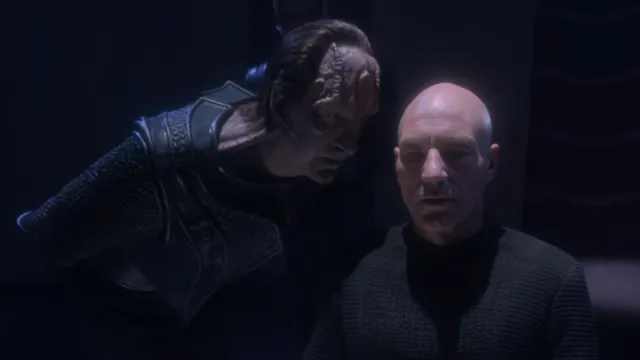Star Trek: The Next Generation – Chain of Command, Part II
"Chain of Command, Part II" is the 11th episode of the sixth season of Star Trek: The Next Generation, first broadcast in the United States on December 17, 1992. Among Trekkies, it is revered as one of the defining moments of the series, remembered for its raw intensity, its unflinching look at the psychological abuse of prisoners of war, and its relentless exploration of what happens when truth itself is under siege.
The episode follows Captain Jean-Luc Picard after he is captured by the Cardassians, one of the Federation’s most complex and morally ambiguous adversaries. He is transported to a secret detention facility and subjected to brutal methods intended to break his mind and extract classified intelligence about a covert Starfleet operation. The Cardassians want more than information. They want submission.

What elevates this episode into Star Trek legend is a single, unyielding exchange. Gul Madred, the architect of Picard’s torment, presents four bright lights and demands that Picard acknowledge five. It’s not about facts. It’s about breaking resistance, one neuron at a time. Madred escalates the pain, confident the Captain will surrender. But Picard refuses.
This moment echoes through Trek history. It’s a direct mirror to the franchise’s DNA: defiance in the face of tyranny. For longtime fans, it recalls Vulcan philosophy on logic and truth, echoes the Prime Directive’s moral weight, and nods to the franchise’s Cold War roots. In-universe, it also foreshadows the Cardassians’ role in later conflicts, including their eventual alliance with the Dominion. This isn’t just torture. It’s a prelude to the storm that will engulf the Alpha Quadrant.
Picard’s Ordeal and Stewart’s Performance
Throughout the episode, Picard endures every conceivable tactic, from sensory deprivation to physical brutality. His refusal to compromise his morality turns him into something more than a Starfleet captain. It transforms him into a symbol. Sir Patrick Stewart has often cited this storyline as one of the most emotionally draining of his career. The performance is stripped to its essence. No diplomacy. No bridge. Just the raw human will to endure.
In interviews, Stewart described the filming process as exhausting, calling it “grueling” and “one of the most personal performances” of his time on the show. What began as a science fiction plot about a prisoner became a study in how far the human mind can bend before it breaks.
Stewart later reflected on how relevant the episode became in real-world political climates, pointing to the erosion of civil liberties and the ethics of interrogation in modern conflicts. The four-lights moment has been referenced in political commentary, military ethics debates, and academic writing for decades.
Political Resonance and Real-World Parallels
“Chain of Command, Part II” resonated far beyond Trek fandom. Journalists and scholars have drawn parallels between Gul Madred’s psychological tactics and real-world methods of interrogation. In 2004, Seymour M. Hersh compared the episode’s depiction of torture to what was later uncovered at Abu Ghraib prison. In 2014, Conor Friedersdorf noted its eerie prescience regarding enhanced interrogation in the post-9/11 era. Star Trek had already imagined the moral fallout of such choices years earlier.
This is part of what makes this episode so unforgettable. Like the best of Trek, it isn’t just entertainment. It’s a mirror held up to power, asking uncomfortable questions about the cost of survival and the fragility of truth when power tries to rewrite it.

Behind the Scenes and Trivia
- The episode was written by Ronald D. Moore, a major force behind several key arcs in Star Trek lore and later creator of *Battlestar Galactica*.
- The torture sequences drew from real testimonies of Vietnam War POWs. Producers consulted former prisoners to ensure authenticity and sensitivity.
- Gul Madred was portrayed by David Warner, who also appeared as Chancellor Gorkon in *Star Trek VI: The Undiscovered Country*. His ability to channel quiet menace became legendary among Trek fans.
- Although widely rumored, Gene Roddenberry did not appear in this episode. This myth has circulated for years but is not supported by production records.
- The title “Chain of Command” nods both to Starfleet’s structure and the chain of psychological manipulation Madred uses against Picard.
- The episode won a Primetime Emmy Award for Outstanding Individual Achievement in Sound Editing and received multiple additional nominations.
- The Cardassians, who feature heavily here, would later play a central role in *Star Trek: Deep Space Nine*, where their political and cultural complexity expanded far beyond their initial portrayal as villains.
Legacy
“Chain of Command, Part II” remains one of the most celebrated episodes of the series. Its exploration of psychological endurance, power, and the resilience of the human spirit is as sharp today as it was in 1992. Among Trek fans, the image of Picard standing broken yet unbroken, whispering “There are four lights,” is etched into collective memory.
This episode is more than a story. It is a Star Trek litmus test. It reveals what happens when authority is unchecked, when reality itself is weaponized, and what it means to resist even when resistance hurts.
For those who study Trek not just as a show but as cultural text, this is required viewing. And for those who love Picard, it’s the moment that defines him.
















